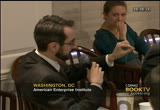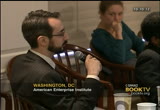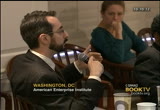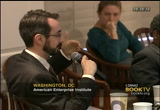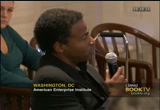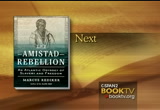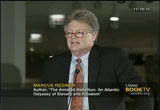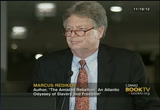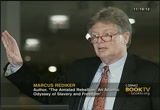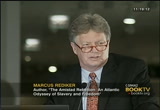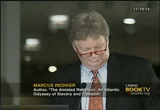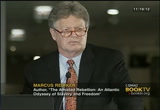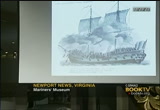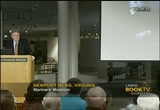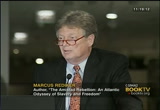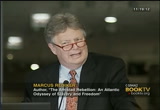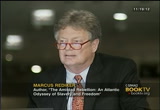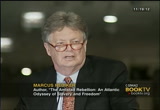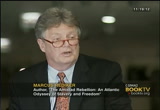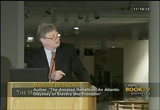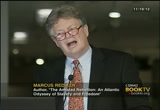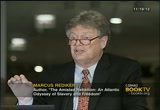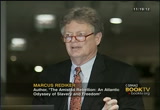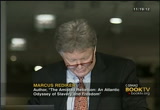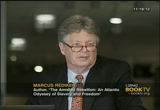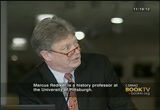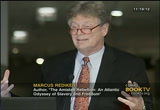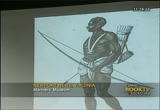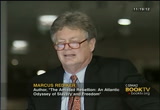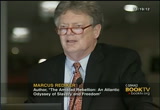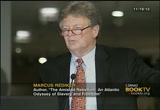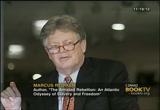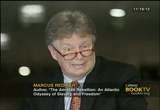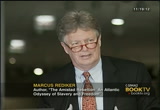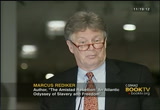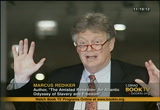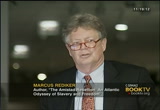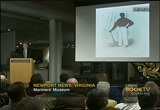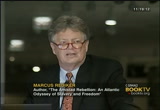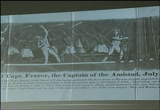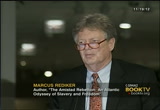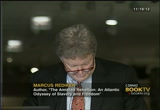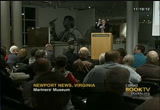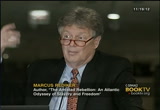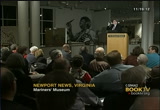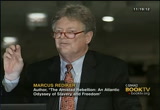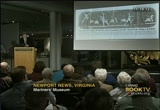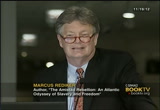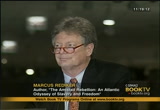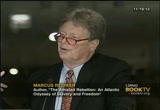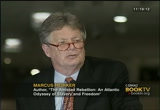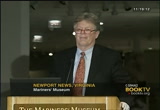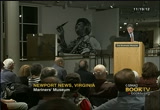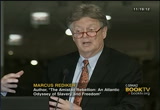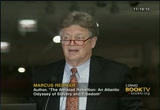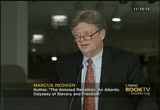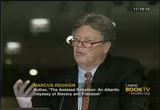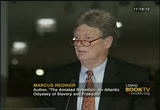tv Book TV CSPAN December 24, 2012 3:00pm-4:15pm EST
3:00 pm
>> i know. it's wonderful. thank you so much. one myanmar quibble with your presentation and then a question. so, the quibble is that you mentioned in passing that human cloning is banned in the united states. that, to my knowledge, is not true. federal funding is prohibited from going cloning in the same way under the rider. there are other provisions. >> you may be correct on that. my knowledge is that cloning for the purpose of creating a human being is, you know, legal. that was my understanding of it. am i not right about that? i am happy to chat some more after. ..
3:02 pm
committee announced a researcher, who discovered induced stem cells -- in particular, -- gord had done cloning work with frogs decade ago. but yaminaka discovered a kind of stem cell that prevents the need to tee destroy human embryos and create embryonic stem cells. he would be sharing the nobel prize this year. coming around to the question. here's president bush's policy, put in place to stop incentivizing and stop the funding -- prevent the funding of the destruction of human embree wyoming in the name of research, creation and destruction of human embree -- imby -- embryos, and it
3:03 pm
encouraged -- ended in a nobel prize. so here's the question. i think that's is a challenge the antiscience and pro science rubric, and i wonder if you'd say that in fact it can withstand that sort of thing as we look at it over time, whether it's a little bit of a too shallow way of looking at things whether it's chris mooney on the left and the approach you have here. the things are more complicate than pro science or antiscience would have thought. >> you're absolutely correct there is a role for bioethics in science, okay and n and i would be hesitant to call someone antiscience if they are objecting to something on biothal grounds. you can gate ph.d in bioethics. that's how complicated this field has become. so i agree there's a value in
3:04 pm
not just plowing forward and doing whatever we want, whenever we want there is a wrote from jurrasic park, we were so obsessed to see if we could do thing, we never stopped to think if we should. so heaven forbid i get my philosophy from jurrasic park, but he makes a good point. i come on the side that embryonic stem cells is something we should be doing, including induced stem cells. you prove we don't need embryonic stem cells. that's not true. induced stem cells, i saw a study where they compared the transcription profile, which is the mrna expression from a cell, and induced stem cells and embryonic stem cells simply are not the same, and we would have never known that had we not stud yesterday embryonic stem cells.
3:05 pm
we have to good side-by-side in doing both at the same time. [inaudible] >> sure. sure. [inaudible] >> our last question. one question i didn't get a chance. i wanted to ask you how you felt about nasa space exploration, the international space station, and the recent expedition and landing of curiosity on mars. how does that play into some of the ideas that you have, if at all, and what are you looking forward to seeing in the next couple of years that you think would be beneficial to not only the country but -- >> boy, that's a great question. you know, i think that pace policy -- i think nasa turning over some of the more routine --
3:06 pm
taking cargo up and taking cargo back -- we call that routine but it's actually very dangerous. i think turning that over to the private sector was a good move. it allows to us focus more on really big projects that the private sector may not be able to fund. i can't conceive of a private company going to mars just because what's the financial payoff? you get to mars, and then, what, it's big red dirt planet? there's not a lot there. so, i see the role of nasa taking more of a broad -- put a moon colony on the moon. that would be cool go to mars, do things like that. if we have the money for that, i would like to see that. and the private sector doing the space tourism and the routine cargo shuttling things. that's a good direction. seems to be that's where we're heading. >> if you look at what is
3:07 pm
happening now, we had private launch to the space station, second private launch to the space station. so, clearly there is funding for it. i am very optimistic. multiple companies competing on space flight designs and that's why a private company will go to mars, bragging rights over the technology the value of the patents and technology that spins off. >> there was an idea that the government would give an award their first team that gets there, $20 billion or something like that. i'm kind of open-minded happen. been married to any particular idea on space policy. we're watching it evolve before our very eyes and it's going to be interesting to see where it goes over the next few years. >> i'd rather see us explore the ocean bottoms first. we haven't mapped them as well as we have mapped mars. on that note i will wrap up. thank you all for your attendance. have a great afternoon.
3:08 pm
>> visit booktv.org to watch any of the programs you see here online. type the author or book title in the search bar on the upper left side of the page and check search. book tv streams live online for 48 hours every weekend, with top nonfiction books and authors. booktv.org. >> next. marcus rediker row counts a slave revolt eye board the am a&m amistad. the men were eventually sent to prison in connecticut where they awaited a trial heard by the supreme court. their case defended by john quincy adamss resulted in their release and return to africa.
3:09 pm
this is a little over an hour. >> greetings, everyone. greetings. good to see you here. thank you for coming out. i'd like to begin with very warm thanks to brian. brian, where are you? there he is back there. brian, has done a lot to make this happen. also thanks to anna for the generous introduction, and i'd say we should also give a round of applause to the staff of this museum, which keeps america's maritime heritage alive. [applause] >> now, i'm very happy to have a chance to talk with you this evening about a part of that maritime heritage which is not always included in america's history of the seas. i want to talk to you about this
3:10 pm
book that i've written, "the amistad bee bellon" and i want to remind everybody what happened in that story. just led me summarize what happened. the year is 1839. and this slave schooner, amistad, which in spanish means, "friendship" kind of a cruel name for a slave ship, i think. contains 53 enslaved africans, 49 men, four children, including three little girls. they are being carried from havana to another part of cuba where the sugar plantation system is just exploding. sugar is a key to cuba as one of the most dynamic slave societies in the world. so, they're on their way on a coastal voyage of 300 miles.
3:11 pm
during that voyage, a revolt at sea takes place. the amistad africans rise up and kill a member of the crew of the amistad, and then they kill the captain. a man named ramon ferrer. they take control of the ship. with the idea of sailing back to their african homeland, which is sierra leon. they keep two of the cubans alive. these were actually their so-called owners. pedro and montez. montez had been a ship captain so he knew navigation. they told him, sail toward the rising sun, because the rising sun had been at their backs when they made the middle passage across the atlantic in the first place.
3:12 pm
well, montes at the -- montes was very clever man. during the day he did sail to the east as he was instructed, but he kept the sails loose and flapping in the wind so as not to make too much progress. and then at night he reversed course and headed back towards the caribbean and the north american coast, in the hope that he would be discovered, that they would be captured and he and his fellow cuban slave own we're be saved. so he trick the amistad africans. eventually they saw that lacking food and water, they were not going to be able to make a long voyage, and so it was asked by montez, do you want me to take you to a free country? and they said, what free country is this? that free country is the united states. well, we're talking about one of
3:13 pm
the leading slave societies in the world in 1839. not exactly a free country. but to make along story short, the africans actually sailed the vessel all the way up to the norway end of long island. where they were taken by a u.s. navy ship, carried to new london, connecticut, and thrown in jail. charged with murder and piracy. now, as soon as word got out that these africans had come ashore, abolitionists from up and down the eastern coast flocked to the jail to try to assist them, thinking this cause might help them to advance their struggle against the institution of slavery. well, a long legal battle took place, for 19 months the amistad africans were in jail.
3:14 pm
they did receive support from no less a person than john quincy adams, former president, at that time congressman, who represented the 36 survivors before the united states supreme court, and won a dramatic victory. declaring them illegally enslaved and, therefore, free, and enabling them to return to their native land, which they did, eight months later, in november 1841. they returned to southern sierra leon, faking with them a group of missionaries, and this is the origin of the american missionary association. who would then create something called, the menda mission. here we have an image of the ship itself. the amistad. and the moment it depicts is the
3:15 pm
meeting with a group of white hunters on that northern end of long island. you can actually see them here. yes? this is the amistad. and in the background this this naval vessel, the u.s. washington on their way to capture them. this is probably produced by an abolitionist artist sometime after the actual voyage. so what we have here is a very important case in the struggle against slavery, important because it was a victory. this kind of thing was not common. the institution of slavery was extremely strong. abolitionists and enslaved africans won a very significant victory in this case. okay. so, this subject has been much stud yesterday, -- studied, and it's been well studied. so you may wonder, why write a
3:16 pm
new become about it? my interest in this case grew out of the previous book i wrote, entitled, "the slave ship, a human history." published in 2007. this was a pretty gruesome subject to study, i tell you. very pantoufle see what was done to so many millions of africans in the pursuit of profits. the terror that was crucial to the management of people on board these vessels. i had to live with this for several years while writing this book, and as i studied the slave ship, what i found was there were a great many rebelons that rode up under the most extreme circumstances. it was really quite inspiring to see the enslaved people kept fighting back no matter what, even when they had almost no
3:17 pm
chance of success. many rebelons, very few successful. why was the amistad successful? i ranted to know. this was an stratosphere counterpoint to a gruesome hoyt, and captured my imagination so i began to read all the work about the amistad. one of hundreds of slave revolts onboard ships, but one of the very few that actually achieved victory. what i found bothered me in this sense. there was very good scholarship on the case, but it was almost all about the legal struggle. very few people have actually
3:18 pm
studied the revolt. very few people had actually wondered why it was successful in the first place? so, it seemed to me that something important had been lost. it also seemed to me that in the process, the real heroes of the case -- by that, i mean the africans who risked their lives to gain freedom -- had been pushed aside, and that politicians and judges judges jd abolitionists had become the main players in the story. john quincy adams, featured here, is i think a kind of iconic hero of the amistad case. and i must tell you, he played an extremely important role, but nothing happened without the
3:19 pm
actions of this man, and those other 52 africans onboard that vessel. theirs was the actions that set everything else in motion. so, i wanted to return to that. and i also wanted to question what had seemed to me to become one of the main arguments about the amistad case, and that was that it was a great success story about the american legal system. the fact that the supreme court could rule in their favor proved that the american legal system was the hero of the case, alongside john quincy adams. to which i ask, do you mean the same legal system that was holding two and a half million people in bondage at that moment? that's the hero of the story? i don't think so. i think we have to go back and look at the rebellion itself,
3:20 pm
and especially to look at those africans who met the rebellion. so what we have in both history and film, is actually very good history from above. history that stresses the likes of john quincy adams. what i wanted to do was to write a different kind of history, what anna called history from below. whose history is it? whose rebellion was it? and what does it mean to us now? those are questions i wanted to pose. well in the course of doing this research, i must tell you, this project was full of surprises. it's a story that everybody thinks they know, and i thought that i probably knew it, too, but it turns out there were so many surprises. this actually put me in mind of a phrase formed by a very
3:21 pm
imminent american historian, lawrence levine, in which he talked about the unpredictable past. it's a great phrase. the unpredictable past. i found that the past of the amistad was extremely unpredictable, and so what aid like to share with you today are some of those surprises. what were the surprises of doing this kind of research? the first surprise -- and in some ways the biggest surprise and the one that made many subsequent surprises possible -- has to do with the sources. the quantity and the quality of evidence about these africans who made the revolt. now, i had spent 30 years studying sailors enslaved africans, pirates, poor people
3:22 pm
who left almost no documents of their own. so i was trained to do this kind of work. to try to write history from below. people who had been really left out of most of the historical narratives. but i must tell you that the body of evidence available about this case, i'm convinced, is the richest and the deepest of any i have ever seen about any group of enslaved rebels anywhere. it is a staggering body of evidence. let me give you a few examples. when i came to study the rebellion itself, i wondered, are there first-person accounts of it? it turns out there are more than 70 first-person accounts of it, told by 17 different people who saw it. two sailors, the two cuban slave
3:23 pm
holders, one watch fro cuban sailor, and it would their version of what happened and some of them told it more than once and at varying lengths. 70 accounts of rebellion. this is extraordinary. but an even bigger key is this. the amistad africans were held in jail, mostly in new haven, connecticut, for 19 months. and during those 19 months, all kinds of people came into the jail to see them. now, you have to know, jails in 1839 were not like jails today. they were much more open institutions. and the jailer, his main objective in all this, is to make money? so, yes, what he did.
3:24 pm
he charged admission. people lined up in the thousands to pay admission and walk through the new haven jail, and to see or to talk with the amistad africans. they found translators. they found two african sailors who could translate back and forth. more about that in a moment. but these people who came into the jail did remarkable things. some of them drew portraits. these were sketched by a 17-year-old artist named william townsend. two of the very important players in all this. this man here, grabeau was probably one of the most important people in this, he was a very important figure in his native society in west africa,
3:25 pm
and here is one of the children, a little girl. she was about nine years old. she, too is going to play a very significant role in this entire case. more about that in a moment as well. so, artists draw their pictures. correspondents conduct interviews. people write about the amistad africans in letters. people publish articles about the amistad africans in their newspapers. what this means is that there are a great many very detailed sources about who these people were and what their lives were like. and now let me just mention two other sets of sources which i found, which proved to be especially important. i found a series of letters written by the teacher of the amistad africans.
3:26 pm
one of the things that happened was that the jail became a schoolroom. and people learned. they learned english, they learned arithmetic, study christianity, it was very important the abolitionist they be taught religious. so this teacher, samuel booth, fund graduate student at yale university. he spent many hours each day with the amistad africans, and in the period running up to their moment of departure to go back to africa, he starts talking to them intensively about where they lived and who they were and what their lives were like back in africa. because that information was going to be crucial to getting them back home. and he wrote a series of letters about this. some of them published in very small abolitionist publications
3:27 pm
but they're full of rich detail about the african lives of these people. that's one very important set of sources. and then there was another. this you have to say is the scholar's dream. we spent, folks, a lot of time showing up in archives and looking for this source and that source and being told, that wing burned down in 1916, and we don't have those sources anymore. sorry, that's all gone. well in 1852, 13 years after the rebellion, a young woman named hannah moore went from the united states to work in thing my in sierra leone, and at a holiday dinner where there were still, i think, maybe four or five of the amistad veterans living at the mission, she asked them to tell their story of the uprising. and then she wrote it all down.
3:28 pm
so, she transcribed their oral history of the rebellion, how they had committed it to their own memory. this is a stunning source, and it contains information that no other source of the time period had. for example, about what was the debate down in the hold of the amistad when they're trying to decide whether to rise up and seize the ship or not? the oral history contained information about that discussion. that's really getting close to the source. and there you actually hear the voices of the people who made the history. so, my point is, there is a huge amount of evidence for history from below. so much so that it's possible, actually, to get to know these people as individuals. you can hear them speaking.
3:29 pm
you can get a sense of their sense of humor. it's a really intimate body of sources. that's the first surprise. the second surprise is not really a surprise, but the fact we could study it is a surprise -- is the utter centrality of africa to this entire story. i wanted to pose the question, what is the big story here? not just what happened in that courtroom. what's the big story? guess what. the big story is a story about slavery and freedom. and it begins in southern sierra leone, and my account begins by asking a very simple question. who were these people? who were those people who made that revolt? what were their lives like before they were enslaved.
3:30 pm
3:31 pm
>> many people could speak, and many of the nonmendi could also speak that, and there's that and the multilingual reality in which these people can speak three, four, and five languages so they were in a position to communicate with each other. this is a very important fact about making a revolt on a slave ship. i'll just give an idea of where they came from. you'll see we've got gambia here, and freetown where the british set up their own colony of sorts. here's the american colony of liberia where some people of african dissent were
3:32 pm
repatriated, and this is the galena coast, the slave trading fortress where they were shipped out. this is further in, closer to the coast, the cono here, and the vie here, but this is the region where most all of them came from. now, what kind of experiences did they have? well, it turns out that one of the most important things that all of the men, all 49 of the men had in common was that they were trainedded warriors. it turns out that southern sierra loene was racked by warfare because the group called the vie with spanish slave traders in this region had gone
3:33 pm
into the interior making war and capturing people to bring them back to the coast to sell, to be transpotted to places like cue baa -- cuba and brazil especially. seeing this may explain why they were successful in carrying off this rebellion. that actually proves to be a very important fact. this is an image of a warrior in the same period, a warrior with poisenned arrows. i show you this image because the man around his neck has a what's called a gree-gree bag that contained spiritually charged substances that would protect the warrior in battle. just to give you an example of
3:34 pm
how this operated, one eyewitness said that he walked into court one day with a snuff box on a ribbon around his neck. now, that person had no idea what he was looking at. he didn't know this was the protective power of a warrior, but that's the way it played out. now, for the mendi, the weapon of choice was not the bow and arrow but the cutless. they fought mostly with knives. guess what they found on board the amistad? they found the box of ma chet tees and it had to seem like a gift from the ancestors. mendi warriors are given knives. guess how they found them?
3:35 pm
it's been a minor mystery. turns out the three little girls who were not chainedded and not fettered and had free movement around the ship found the box of machettes and told the men where they were. the little girls played a very important role in the successful revolt. now, going back to west africa for a moment, something that i learned about as i think being especially important is this. i wanted to know what were the experiences of self-organization that the people on the amistad would have had? what were their models of self-organization? what kinds of organization had they known in their native societies? turns out there's one in particular that was especially important something called the poro society. this is an all-male secret society. there's an equivalent for women, and it's very prominent among
3:36 pm
mendi and among the temni, all the groups of sierra leono have this society, and what the society does is fundmental in the way in which those societies operate. the society trains warriors, creates social discipline and deals with disputes. they deal with witchcraft. the society declares war, and they actually have a word or two words for the goal of the society in the way it operates in the african societies with the goal to create what means one word meaning unity. everybody agrees one word, we are unified in purpose. everybody is doing the same thing.
3:37 pm
there's that creation of social discipline. well, i read a lot about mendi society and the other society of this region, and i learned a lot about the poro, but i came up against a real dilemma, and the dilemma is anyone initiated into the poro is charged on pain of death you must never reveal any of the secrets of et -- et cetera lore. how do i prove the society and means 6 organization if nobody is never going to mention it? now, i was sure that in the hull of the amistad i was sure it was a displaced society meeting and deciding whether to declare war and seize the vessel, but i couldn't prove it. for the longest time, i couldn't
3:38 pm
prove it, but i finally found two pieces of evidence that convinced me it was a poro meeting. the first written by a missionary when they returned back to sierra leone, a moment of truth because the africans were going assure, and there were many of their own people, mendi, kono and others there to greet them, and what they began to do is shed their western clothing. now, this really upset the missionaries. this was the reversion to heathenism. this was awful, but something else was going on. they didn't take off the clothes to defy the missionary, but in order to show everybody their
3:39 pm
country marks, the ritual scarifications they had which showed which ethnic national group nay -- they were a member of. this is very important when you game wac to sierra leone so they were showing their poro marks, the society presided over this scarification, and suddenly, at that moment, the missionaries, began for the first time, to understand the importance of african cultural forums, and one of them wrote, you know, the marks they have, they are very important to them. they are very proud of them. they are badges of honor. they are part of their identity. well, yes, no kidding. yes, that's exactly who they were. finally, they saw it. you could see the role of the poro in people's identity at this crucial moment, and then came the second piece of evidence. in that oral history that's
3:40 pm
talking about the debate and the hold of the amistad, one of the people there said, i think it was sinke, who was for war. turns out four of the men were not for war so a debate broke out, and then an elder, another part of the west african society, the elder, a very important figure, an old man stood up and basically addressed the four men saying they were very likely to die. do you want to die an honorable death fighting for freedom? they said, yes, they would. at that point, the oral history says we have one word, one word, and that one word was "war." they even used the english
3:41 pm
translation, one word, and so, again, you see the poro society operating in the hold of the vessel. okay, so this is a very important part of the african side of the story. the other thing that i thought was especially crucial was what happened in jail. now, in the courtroom not only blinded us to the rebellion, but to what was happening in jail for 19 months. what was happening in jail was that you had african rebels and american app ligsists meeting -- abolitionists meeting face-to-face, trying to figure out how to cooperate. it was a very important moment. i don't think anything like this happened before so they had to build an alliance if they are going to effectively fight the institution of slavery. well, what i identified as the crucial process among the
3:42 pm
amistad africans was basically to go back to something that is frequently discussed in the slave trade, and i talked about this quite a bit in my book on the slave ship, and anthropologists have a term called "kinship," people who are not really related to each other create relationships of kin and act as if they are really related to people. this was going on those slave ships. old kinship systems shattered. they are creatively trying to build something new. this began at the fort and continued on the first slave ship and continued in cuba, this continued on the aims, and this continued in jail, and one of the most impressive things you will see is the way in which this group of multiethnic africans hold themselves together as a group.
3:43 pm
unified. always pushing for their single objective which is they said it repeatedly, we want to go home. their idea of freedom was to resume the lives they had in sierra leone before their enslavement, and then about a year into their jail experience, something new happened, and i thought this was remarkable too. they came up with a new name for themselves, these africans. they began to call themselves the mendi people. they were not all mendi, but they had heard people saying in jail there's this powerful sovereign force called the american people; right? that's the source of all power in this republic, the american people. they said, oh, okay, you're the american people, we're the mendi people. we're equals. american people, mendi people, and they used the phrase "the
3:44 pm
mendi people" to make their political demands and even to instruct john quincy adams about what to say to the great court when it came time for them to hear their case. my point here, and this is the second big surprise, is that the african side of the story really matters in terms of how the rebellion happened and how people organized themselves in jail. makes a huge difference. the third surprise -- the third surprise is basically this -- nothing i read about the amistad case prepared me to understand how tremendously popular it was. now, i mentioned the groups of people lining up going through the jail; right? paying admission. you know, folks, tens of
3:45 pm
thousands of people did that. 4,000 people alone on the first day they were in new haven jail, 4,000 people filed through there. it's extraordinary, but look what happened. artists come in, okay? you saw some sketches. one man came in and took castings and then created 29 life size wax figures of the amistad africans, assembled them, and charged admission to see it. another artist drew a panorama painting 135 feet long. folks, that's miranda -- more than twice as long than the ship was. he would roll it around and charge admission. that shows how fascinating people were in this case. they wanted to know everything
3:46 pm
about it. now, this is all in the context of a northern society that historians now discoveredded was quite racist. there were violent mob attacks on free black communities, violent mob attacks on the homes of abolitionists, and violent mob attacks on interracial churches. this popularity is remarkable alongside these other things that are very common in the 1830 #s. well, one of the most remarkable aspects of the popular interests was that a newspaper called the new york sun, a penny pressed paper, took a tremendous interest in this case. now the penny press you would need to know was a new kind of newspaper meant for a broader part of the population, the old
3:47 pm
commercial newspapers, they were commercial, and they were bought by merchants, middle class people, people involved in commerce, and the penny press was for working people, especially in new york so the editor of the new york sun sends not only correspondence to new lone done and new haven, but he also sent artists, and i want to show you what one of them produced. now, this is an amazing image. here's the pose of a heroic cop qerer, with his machette in his hand. he's like an avenger of justice, is he not? put this in the context of most of the graphic representations of people of african dissent in
3:48 pm
this period were racist in the extreme. this is a very different image. first time i saw it, i thought, my goodness, must be a abolitionist group. nope, it's the new york sun. why did they do it? because they thought they would make money selling this image, and guess what? they did. they printed and reprinted and reprinted these images because people couldn't get enough of them. alongside this, the reporters are writing accounts of the rebellion that are very, very favorable, very positive. you might even say romantic. some of the earliest accounts are very elaborate descriptions of what a hero he is. this is really unusual. my point here is that the
3:49 pm
amistad africans captured the imagination of popular culture in a way that made their case extremely unusual. the degree of popular interest in the case i argue in the book had an impact on the legal decisions taken because at every step of the way nobody thought they were going to win any of the legal decisions, and every judge in their favor acknowledged the extraordinary popular interest in the case. how could they avoid it because every time the africans came to trial, the courtroom was crowded to suffocation. there were so many people packed into that courtroom that no one left in the break for fear of losing their seat. the popularity of the case, i think, was very important to its
3:50 pm
outcome. finally, the biggest surprise of all, the biggest surprise of all is just how wildly improbable the whole thing is. i mean, think about it, this motely crew of 53 africans, somewhere in the northern caribbean draw pop their war your skills and their poro society background to launch a rebellion, and they seize their ship, okay? that's remarkable in its own right. the really wild part of it is over the next two years that action they took will cause the most powerful people in the world to debate the meaning of what they had done. the queen of spain, the british
3:51 pm
parliament, two united states' presidents, supreme court justices, the american congress, the queen of england, they are all paying close attention to the debate. what do we do about these africans who have taken courage in hand and seized their own freedom? well, their self-emancipation, i want to suggest, had a lot of ripple effects around the atlantic, in europe, in africa, in the caribbean, and in america, especially in america where it had the impact of radicalizing the abolitionist movement, and by that i mean that more and more people began to recognize that the resistance of enslaved people was crucial to abolition.
3:52 pm
they began during the time of the rebellion to quote a famous line from lord byron. this is repeated again and again and again running all the way up to the civil war, and that line was those who would be free must themselves strike the first blow. in other words, action from below can be a trigger. this had a very dramatic impact op a lot of leading african-american intellectuals like henry highland-garnett, frederick douglass and had a big effect on a man named john brown who wanted to strike the first blow at harpers ferry. i guess this is the final thought i leave you with. one of the most remarkable things about movements from below is that they are unpredictable. you never know when they are going to arise or how.
3:53 pm
these -- these things that rise up, these demands for justice, these demands for equality, these demands for freedom, they are unpredictable, and in their unpredictability, i think they are also a great source of hope. thank you very much. [applause] we have time for questions, and i hope you have some. we would like for you to speak into the microphone if possible. >> during the discussion, you talk about roaming around on the decks. i was always led to believe as slaves were brought on to the ship, they stayed shackled until
3:54 pm
they were in the new world. was this different or get free somehow or do we know? >> yes, a good question. the standard practice on slave ships was for the men to be shackledded, but not the women or children unless the women engaged in resistance, in which case they were shackled like the men, and many did. they were not shack shackled to a particular place. two men shackled at the wrist and ankle, and if they were going to move, they had to coordinate movements in order to get, for example, to what they called the necessary tubs on the lower deck. that's a republican why you had to be -- a reason why you had to move around. they had to come up and below. the amistad africans were chained and chained together in a large number. one of the questions has always been how did they manage to get out of their chains?
3:55 pm
well, i'll tell you a fact about who they were as africans. two of them were black smiths. [laughter] that would be your hope to have two black smiths who are there. basically, they managed to break a central padlock to free themselves, and that's what enabled them to come up on to the main deck and to begin the rebellion, but, you're right, a good question how people actually got free in order to wage an uprising. >> hi. i'm fascinated by the with the of actions from below serving as a trigger. i'm curious if you could discuss why you think the amistad rebellion captured the american imagination in a popular way when rebellions on plantations captured the american imagination in a negative way. >> a good question. everybody hear it? why was the amistad rebellion able to capture the imagination when, for example, turner's
3:56 pm
rebellion did not. okay, there were no positive depictions of nat turner in the media as far as i can tell or anyone else can tell. okay. here's something about the amistad case that made it safer for popular support. first of all, they were not african-american slaves. they were africans. okay? that mattered. secondly, slave owners were not american slave owners like john c. calhoun or others. they were cuban slave holders making it easier to vilify the cuban slave holders, okay? it's a little bit different so it's a little bit safer, but i would emphasize that is not an easy distinction to maintain.
3:57 pm
in other words, i have never read about any american slave owner who would have liked to see an image like that. [laughter] you don't glorify and lionize slave rebels. it was pointed out clearly to the americans saying, so and so, you're going to say it's legal when these people kill a white man, a figure of authority, and capture a ship? all of the slaves in america will be very interest the -- interested to get this news, okay? there's contradictions there, but i do believe the fact that it came from outside the united states into the united states meads it a little easier, but the other thing, i think, that really does matter is that this was a really very dramatic
3:58 pm
advance, and what struck me about the popular side of it is that they were interested in who the people were as africans, and there was some kind of exotcism in it. a lot of these people had not seen africans before so authority -- so that was part of it, but on the other hand, the rebellion itself was the thing they really wanted to know about. that's why the paintings have this -- okay, this is actually a a -- an engraving done by a connecticut artist. it's kind of contra kick -- contradictory, isn't it? here's the cabin boy. he's the captain killed by four men, and, actually, that was
3:59 pm
actually, that was accurate. it was four men who surrounded him. here's the ship's cook, already dead. here's ruiz, all done by people done in the jail and knew who the africans were so you can tell that's sinke right there. you can recognize him. that's definitely him. this is a man named gravo. sorry, that is konama. the fact that you get close to the rebellion, i think, was very exciting to people. one thing i did mention is that six days after the amistad africans came ashore in new london connecticut, a play was being performed in new york about their uprising. only took six days, and it was a hit, it was a hit in a theater it was a black and white working
4:00 pm
class audience. i estimated that thousands of people saw that play, and they learned about the rebellion that way, and in that play, sinke is depicted as a hero. all of these things are counter intuitive, aren't they? you know, that's part of why this project was surprising. i did not expect to see this level of not only popular interests, but a sympathy in it. a lot of people went to the jail and said, i hate the abolitionists, but i really support those africans. the abolitionists are dangerous extremists, but we support these people. we want those people to be free. it's interesting that it expandses idea of slavery beyond the community. yes? >> yes. what happened to the slave owners after -- after they came ashore? >> yes.
4:01 pm
the slave owners came ashore, and what's interesting their demands were quite simple, give us our slaves back. there was a question raised from the beginning that the slaves were not legal slaves because spain signed a treaty with great britain promising not to import new slaves after 1835 so the cuban slave owners clever ri gave the owners spanish names to represent them as having been cultured on the island. that, everybody could see, was false because they didn't understand a word of spanish. [laughter] it was interesting to see. the slave holders stayed in connecticut trying for awhile to get their property back, their human property, and then something dramatic happened. louis, a leading abolitionist, once they found translaters so
4:02 pm
the africans told their side of the story, louis arranged to charge both of the slave owners with violence assaults based on beatings they gave the illegally enslaved people on the ships. they were both slapped with jail. this is a dramatic moment, especially in the south because they said well what happens to a southern master who goes north with slaves? slap us in jail? that's exactly what louis wanted to do, slap them in jail. that's why there was a bounty on louis' head in the south. he was reviled. they eventually gave up and went to cuba, the short answer, but they waged a battle, and the queen of spain carried on requesting reimbursement for these slaves all the way up through the civil war. yes? >> what was the length of time from the time of the rebellion
4:03 pm
until they got to new york? also, is that the first time anyone not on board the ship was aware of the situation? >> yes, good question. the rebellion took place, and they were at sea for about seven weeks before they got to the upper end of long island. now, we know from the accounts of the void that they stopped 30 times. mostly to get water. they didn't have enough water. we also know that montez, the slave owner and the one who knew navigationmented to take them to charleston, south carolina. that would have been a different outcome. this is revealing, when the amistad africans saw, and i'll go back to the early image which depicts it, you see here, when
4:04 pm
they came ashore, they were hungry, thirsty, but when they saw these white men, hunters, they department ask for food or water. the first thing they said was, and this was one man who could speak a few words of english said, "is this slavery country?" interesting political idea that some parts of this world were slavery country and some parts with respect. had they gone ashore and asked that question in south carolina, i don't know. i don't have evidence to prove they did. they might have. basically, they had an idea that they had to get to a place that was not slavery country in order to have a chance to be free. i think they were right about that. this is a very important fact about why they won, the fact
4:05 pm
they were able to sail the ship about 1400 miles far enough north, and when the man told him, he said, yes, this is not shave ri country, but a free country. slavery was abolished in new york, and they cheered and exhalted and were thrilled and happy, so much so they scared the white hunters who got their guns and said no, no, no, we're just happy. it was really literally the case that they worked their way to freedom by sailing that ship in getting to a place where they had a chance to win freedom, but, see after that, what matters is the alliance they build with the abolitionists while they are in jail. yes? >> is there a media black lash among southern states promoting their own ideas, seeing the
4:06 pm
popularity of the amistad in the north, and does this lead to political ramification where they really point to the north saying, see, they are not on our side, they are not like us and leaning more towards the rebellion? >> a good point, and it is certainly true that the southern newspapers are very, very angry and demanding, literally from the beginning, these africans be taken back to cuba, immediately. they are unequivocally slave property and must be sense back. now, what's interesting about the media backlash is that it turns out other major penny press newspaper, the "the new york morning herald" is radically pro-slavery. they also send correspondents issue and so you'll frequently find the "new york sun" and the
4:07 pm
"new york heral d" cor responsibilities writing about the same events in different ways. they are appalled by the popular interest in this case, worse than appalled, but infuruated. those people you taut are just cold-blooded murders. there's a big, you know, kind of fierce debate, and, of course, the fact that the debate goes on makes everybody else more interested in the case. >> yes, sir, during the 19 months of the -- that they were jailed, how were the three little girls caredded for? was this any special attention given to them in your research? >> yes, okay, i'm so glad you asked that question because i wanted to go back and show you what a difference history from below makes to the story. okay. remember professor gibbs consistenting --
4:08 pm
counting from one to ten? there was a story after they moved to new haven where a man says the three little girls were teaching gentlemen how to count from one to ten in their native language. the best idea the professor had he got from the three little girls, okay? they were in an unusual position, and they were actually the source of considerable conflict between the amistad africans and the jailer because what the jailer did was remove the three little girls to become his personal servants. in his house. i tell you the other men didn't like it one bit. partly because it separated their collectives. they wanted to keep everybody together, but there was nothing they could really do about it because the jailer had power over them in jail. well, eventually, began to complain because the three
4:09 pm
little girls were not learning to speak english as well as the little boy who was their couldn't point of a boy named calliet, and they were blaming, then, the jailer for not contributing to their education. whereupon the jailer and wife made several racist comments, you know, about why would you want to try to educate these monkeys anyway? this became part of the tension, but the little girls #w-r put into a different category, and then there was, later on, a very big battle over who should be their proper -- who should be in charge of their lives basically, and were removed from the household of the jailer, and then then lived with an abolitionist close to the african himself. >> [inaudible] >> the question was did they go
4:10 pm
back to sierra leone? yes, they did. all three little girls remained with the mission for many years, and, right there, she actually came back to the united states and became, i do believe, the first black female graduate of overland college. then went back to sierra leone as a missionary herself. most found their families and did what they wanted to do when they got back. they wanted to go back to their lives. there's a continue -- a tragic point for sinke when searching for his wife and children, he found the village was completely destroyed in the
4:11 pm
warfare that continued after his own enslavement. it is true that the larger reality of war and slave trade was beyond his ability to control it, even though he did win one great victory, he lost his family. >> a question about the missionaries. i believe you talked about how missionaries teach, whrrnt they embraced christianity or not? how well did the missionaries think they succeeded in converting africans, and in what ways did the africans use them to further their own end? >> yes, good question, thank you. the -- i think the missionaries including the abolitionists like louis, were properly realistic
4:12 pm
in saying that they were willing to study christianity, but they did not think they embraced it as belief. maybe a few had, they hoped. turns out this is a really interesting and complex question because clearly the amistad africans recognized what was important to the abolitionists, and so their attitude was you want us to study your language and religion, we'll do it, but at the same time, we're going to invest on our own io deppedty as the mendi people. you could say that their african identity grew as a counterpoint to the idea that they should be civilized pie yous christians. now, all of these tensions were
4:13 pm
on displace because once the supreme court ruled in their favor and said they could go home, well, the supreme court said they had to have speedometer to pay for the going home, how were they going to get home? well, for the longest time, people believed louis and other wealthy abolitionists paid for this, but, in fact, what happened, the abolitionists with the cooperation of the africans organized a big tour up and down the eastern sea board in which the africans would go and speak and perform their knowledge of christianity, perform their knowledge of english, perform their civilization, and, at the same time, insisted on singing their native african songs, the african side was always there, and here's the wildest part of it all -- the main event in
4:14 pm
every one of the performances, and, all, by the way, performed before packed houses, i mean, the -- couldn't get everybody in who wanted to see them. churches who held two and three-thousand people. the highlight of every event was when he rose to take the floor to tell the story and literally act out the rebellion, and he spoke only mendi. this was the way they were going to do it, and i can't tell you the number of people who comment. they say it was one of the most powerful oracles even though we
622 Views
IN COLLECTIONS
CSPAN2 Television Archive
Television Archive  Television Archive News Search Service
Television Archive News Search Service 
Uploaded by TV Archive on

 Live Music Archive
Live Music Archive Librivox Free Audio
Librivox Free Audio Metropolitan Museum
Metropolitan Museum Cleveland Museum of Art
Cleveland Museum of Art Internet Arcade
Internet Arcade Console Living Room
Console Living Room Books to Borrow
Books to Borrow Open Library
Open Library TV News
TV News Understanding 9/11
Understanding 9/11